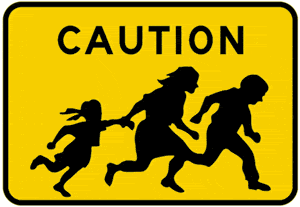Hispanics and the Law
Taylor Scott, American Renaissance, March 2004

In most parts of the United States, Hispanic criminals are reported in police statistics as “white,” thereby artificially inflating the white crime rate. California, one of the few states that keeps separate statistics on crimes committed by Hispanics, reports that they are more than twice as likely as whites to be arrested for rape and other sex crimes, and about three times more likely to be arrested for violent crimes of all kinds.
There are no publicly-available ethnic breakdowns on sexual offenses against children, but news accounts suggest a predilection among Hispanic predators for very young victims. All but one of the following incidents were never reported outside their local areas, and a thorough search would no doubt uncover others. To be sure, horrible offenders are found in every ethnic group, but the following haphazard collection of assaults — all of them recent — suggests a unusual level of odiousness. Had the perpetrators been white, some of the crimes could well have become national news.
In July 2003, police charged José Alvarado, a Salvadoran illegal, with raping the five-year-old son of a woman who rented him a room in Rockville, Maryland. Mr. Alvarado was deported in 1998 for molesting a 10-year-old boy, but sneaked back into the country to commit a similar crime.
In Denver, Colorado, Erick Salazar-Rivasplata was sentenced on Sept. 12, 2003, to at least 60 years in prison for kidnapping and raping first-grade girls. In the fall of 2000, he abducted and raped a seven-year-old as she walked to school. In January 2001, he committed the same crime with another seven-year-old. Prosecutors said Mr. Salazar-Rivasplata “planned, watched and waited” for his victims.
In 2001, Salomé “Sal” Gonzalez was convicted of raping a nine-year-old girl and photographing his crimes. In March 2003, while he was in prison, officials found evidence that he raped and killed an eight-year-old in Pontiac, Michigan, in 1995. He had raped her on numerous occasions, and when she threatened to report him he shot her in the back yard of her home.
In May 2003, Oregon police arrested Tania Sonia Perez, 31, for letting two Hispanic men have sex with her 11-year-old daughter. Miss Perez’s activities came to the attention of authorities when county juvenile officials discovered her daughter was pregnant. The girl turned 12 before giving birth to a baby girl in August.
In September 2003, Miami police arrested Elias Rapalo, 32, a Honduran immigrant in the United States on an expired visa. His DNA matched forensic samples from a series of seven rapes of victims ranging in age from 11 to 79.
On Jan. 28, 2004, the Justice Department announced the indictment of three Mexican brothers on charges of smuggling young girls into the United States and forcing them into prostitution in the Atlanta area. Juan Reyes Rojas, José Reyes Rojas and Raul Reyes Rojas promised the girls jobs, marched them across the border, and forced them to have sex with many men every day.
On May 19, 2002, eight Hispanics brutally gang-raped a girl in a Madera County, California, vineyard. The victim was 12 years old.
In March 2003, Raul Cortez-Herrera and Gabriel Hernandez were charged with rape in Montesano, Washington. Their victim was also 12 years old.
On New Year’s Day 2003, four members of a Hispanic street gang kidnapped a 16-year-old girl in Des Moines, Iowa, and drove her around for three hours while they took turns raping her. The men stopped for refreshments at a convenience store, and police were able to identify Juan Murillo, 22, from the surveillance video.
Of these crimes, the only one to get any publicity was that of Waldina Flores, a woman who molested the daughter of a Florida family who employed her as a nanny. Miss Flores admitted in a Fort Lauderdale courtroom that she began molesting Lauren Book when the girl was 12, and continued doing so until she was 16. The girl’s father, Ron Book, said the 35-year-old Miss Flores “brainwashed” his daughter. On Oct. 10, 2002, Miss Flores was given a 15-year sentence but continued in prison to write Lauren letters that her father called “disgusting and despicable.” This story became known only because Mr. Book was an influential Florida lobbyist.
Miguel Loza is accused of slashing a 17-year-old California girl’s throat and then raping her friend. The 17-year-old died six months after the February 2003 attack, never regaining consciousness. Mr. Loza faces charges of homicide, sodomy, assault with a deadly weapon and forcible sex assault on a child, but prosecutors in Santa Cruz County cannot bring him to trial. Mr. Loza fled across the border and is behind bars in Mexico City, but officials there refuse to extradite him.
For years, Mexico has refused extradition of citizens who may face the death penalty, and US prosecutors have sometimes managed to get their hands on Mexicans by promising a maximum penalty of life without possibility of parole. In October 2001, the Mexican supreme court ruled that life without parole violates the Mexican constitution. As the San Francisco Chronicle explains, “Extradition is now routinely denied in more that 40 categories of serious crime that are punishable by possible life terms under California [and other state] law.”
This policy has made Mexico a haven for murderers. A Los Angeles prosecutor has compiled a list of 246 suspects — most of them accused murderers — known to have fled to Mexico, and this is only the number wanted in California.
Mexican courts sometimes prosecute fugitive criminals, but are often lenient toward those who kill in the United States. In one case, a man wanted for murder in Los Angeles was sentenced by a Mexican court to eight years in prison, but on appeal, got only weekend jail time. He soon returned to Los Angeles, where a prosecutor explained he could do nothing because of the US Constitution’s prohibition against double jeopardy.















